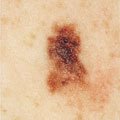
I have added an element to my blog. I have a quick quiz along my side bar. Please locate it and take my Melanoma quiz. I promise, no failing grades!
Thanks!
This blog was originally to serve as my project for my research class. I had chosen a "fun topic" which involved one of my passions, which is horses. After picking my topic I discovered my husband had become diagnosed with malignant melanoma. My fun topic, "Dancing Horses" took a back seat. I would now like to share what I have researched on Malignant Melanoma. Please take the time to learn to protect your loved ones. I hope you will learn something, as I did from this project.



2 comments:
The most important thing is to find potential melanoma lesions early while removal can be a cure. People at high risk (especially if you have already had a melanoma) need to follow their skin closely. The traditional ABCD criteria can help guide risk assessment. A, for asymmetric lesions; B for moles with irregular Borders; C, for colors in the lesion; and D, for diameter greater than the tip of an eraser.
More recently physicians have recognized the importance of moles that are new or getting larger in predicting high risk lesions. They have now added E for enlargement to the criteria and many recommend following the ABCDE’s. Having reliable information on whether a mole is changing increases the specificity of the skin exam and could therefore reduce the over-diagnosis of suspicious lesions.
Although dermatologists almost always ask if you have any new or changing moles most people cannot accurately answer that question (particularly those with numerous moles and the greatest risk). One way to approach this problem for people at high risk is to use Total Body Photography to document the moles on your body. However, this is an expensive procedure (often costing $400-$600) that most insurance providers will not cover.
There is now an inexpensive software program that allows people to use their own digital cameras at home to take their own body images at different time intervals (maximizing privacy). The images can be scaled and aligned and compared using a personal computer to allow for the efficient recognition of new or growing moles. This software was developed from funding provided by the National Cancer Institute and can be obtained by going to the website dermalert.com
Thank you Brian, very useful information! I will add the dermalert site to my links. Kevin will be following with a dermatologist and they did speak of taking total body images of moles.
Post a Comment